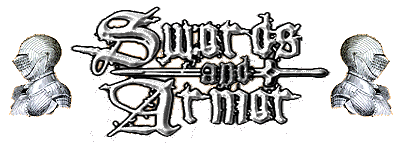
Blue Finish with Pivoting Visor
The difference in the types of color in Armor has confused many of those who seek to acquire different styles from different time periods. Why was some armor made brown, some blued, some black and some shades in between? Was it different time periods or different countries that made the colors their own? A little of both is the answer.
To understand how the colors occurred, one has to realize the type of conditions and tools that an armorer, even a Master Armorer had at their disposal. Most Master Armorers were attached to a court of nobility, or in Northern Europe, a guild, which in turn, depending on their location, would develop massive foundries close to natural resources that would allow a large production, if needed, for an army. These were huge industrial complexes capable of making armor in an astonishing short amount of time, although it was probably a fact that, unless a soldier had pieces available to him through inheritance or favorite armor that he wore already, most soldiers would end up not fully protected by battle time, no matter how good the armorers were or how fast they worked.
Smaller foundries existed but the armies were dependent on these larger foundries to provide, in a very short time, enough armor and arms to protect them from harm. In a rushed situation, even the best armorer would produce inconsistencies as the process of making the armor began from scratch with making the iron or steel pure. Why did they need to get out impurities? The strongest steel was the steel that contained the least amount of these impurities yet even the best of steel from that time period had a streaked appearance due to the nature of the work and the unfiltered impurities that were left behind in this part of the process.
This metal was ‘worked’ by heating and melting it, shaping it into the form needed and then hammered repeatedly, refolding it until it met the critical eye of the armorer’s satisfaction. This is a short version of the process for those already beginning to think they should move on to something else.
The coloration of a finished product had as much to do with where the ore metals were located as well as how it was treated during the smelting process. This is why certain regions and governments and their armies were more distinctive on the battlefield. A quick glance at their armor’s color and its style let the soldier know who to look for and who was friend or foe in a quick glance, which could make the time available to protect and save his life. Perhaps those Master Armorers would take the ore where they wanted it to go with coloration after all.
Medieval Helmets Medieval Weapons Index
Other Medieval Helmets and Helms
Swords and Armor Bargain Dungeon
!
New Introductions -
Closeouts - All Great Bargains
Shipping Policies and Rates - Returns
Payment Methods
We accept Visa, Master Card, American Express,
Discover Card and PayPal
copyright © 2001-2014
swordsandarmor.com . All Rights Reserved
privacy
policy